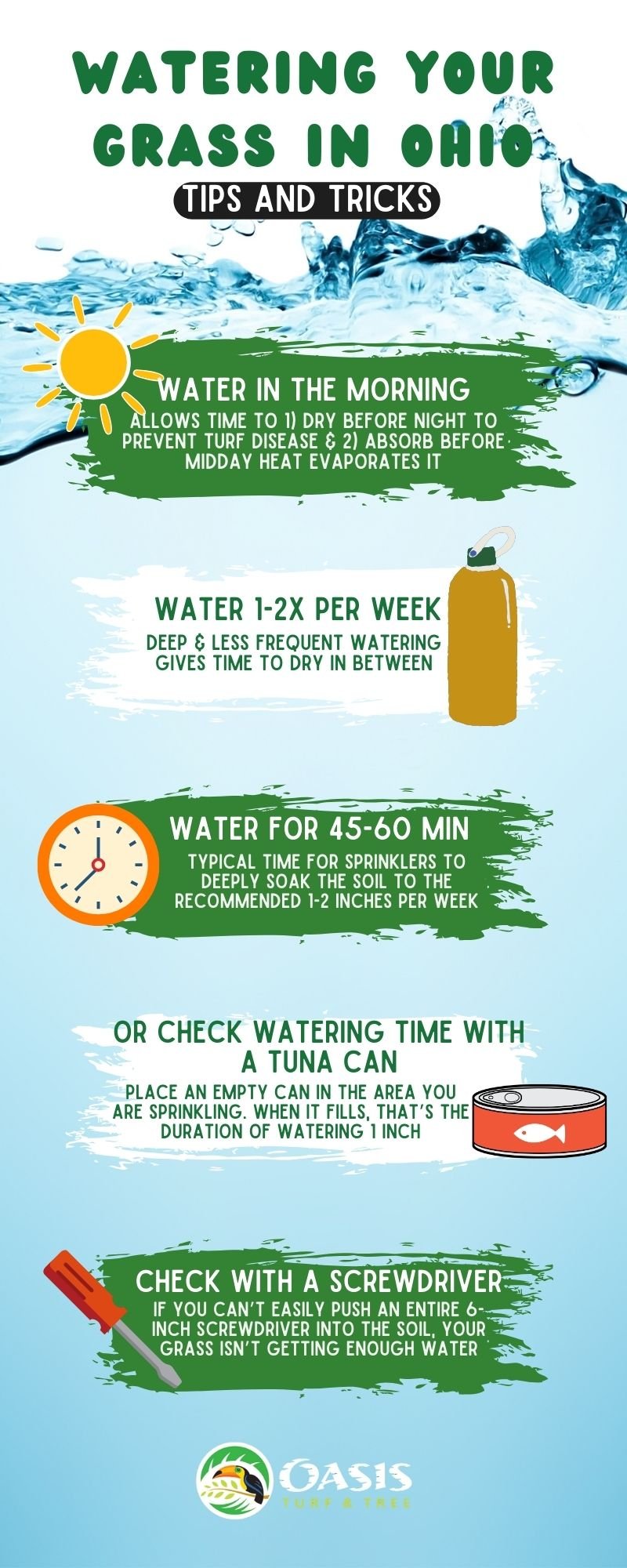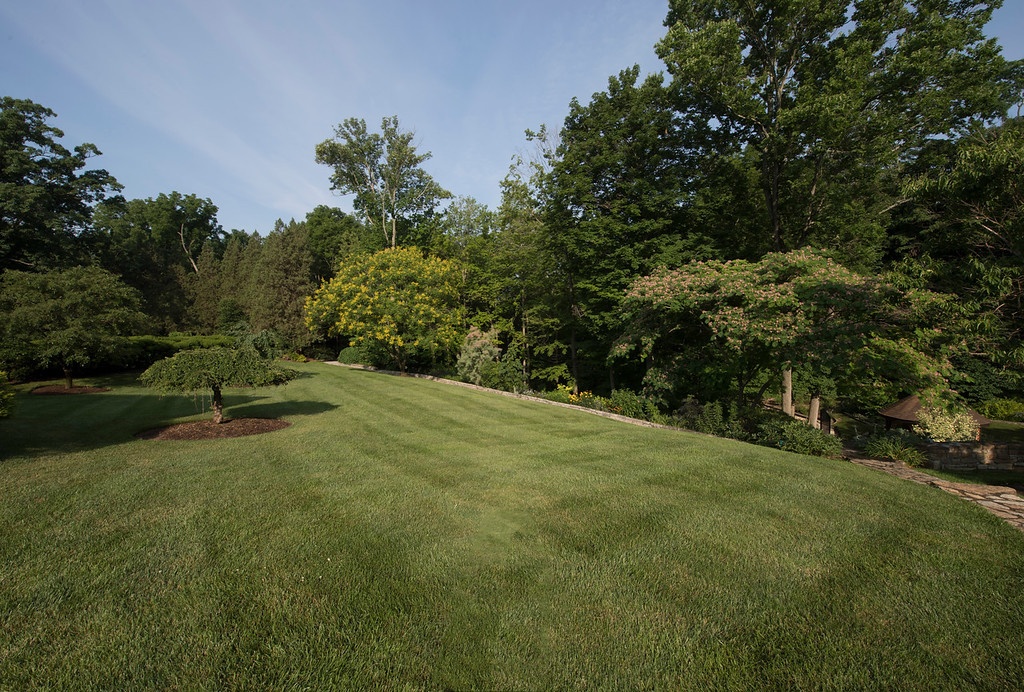Water is found everywhere on Earth – from the polar ice caps to the steamy geysers, and it’s an essential element for life to exist.
In general, lawns are fairly resilient and can handle a variety of conditions, but without water, grass struggles to survive. And while watering your lawn may seem like a simple task, there are many misconceptions regarding the best time to water grass in Ohio, and which are the best techniques for watering established lawns.
While homeowners have the best intentions when it comes to watering their lawn, these misconceptions could lead to potentially damaging mistakes. For example, there’s a common misconception that it doesn’t matter when or how often you water your lawn and that as long as your grass is getting water throughout the week, it will be fine. However, watering at the wrong times can actually do more harm than good.
Although the physical task of watering your lawn isn’t incredibly complicated, having the knowledge to do the job correctly often leads to better results.
When it comes to caring for your lawn, we believe that lawn care companies and homeowners should work together for combined success. Below, we’ll provide you with expert tips on when and how to water your lawn. We also have this helpful video filled with lawn watering tips.
If you've recently seeded your lawn, check out this article for instructions on how to water after aeration and overseeding.
How Much Water Does Your Lawn Need?
Lawn care is a year-round process, and it’s important not to underestimate the importance of water for established lawns.
Lawns need one to two inches of consistent water per week. During certain times of the year, Mother Nature may provide enough rainfall to keep your grass growing. However, it’s common to have dry spells for several weeks or more in Ohio.
When lawns aren’t getting enough water, you’ll often notice the following symptoms:
- The color changes from a vibrant green to a much duller blue-green (and later, brown).
- After walking across your lawn, you can clearly see footprints in the grass that won’t stand back up.
Established lawns can withstand a couple weeks without rain or watering, and it’s normal for grass to enter dormancy as a response. Once the grass starts getting water again, the grass will start growing again and color should return. However, don’t be completely surprised if your lawn doesn’t bounce back to normal. As you begin to water your lawn, you may notice thin areas or dead spots when moisture has been absent for longer periods of time.
Even though grass can rebound from brief periods of drought, there are long term consequences of insufficient water to a lawn. As grass areas weaken and thin, weeds will quickly fill the gaps. Weeds will grow and proliferate, and take over large areas, simply because grass didn’t get water regularly.
Understanding the best time to water your grass – especially on a hot summer day – is important for the health of your grass. While it’s not rocket science, it’s always good to get a reminder of the basics.
When is the Best Time to Water Your Lawn?
Morning, is by far the best time to water your lawn because it gives your grass plenty of time to dry before nightfall and to absorb as much water as possible before it evaporates. This is especially important when night temperatures are over 70 degrees and day temperatures are above 85 degrees.
Avoid watering your grass in the middle of the day or at night. In the middle of the day, when the sun is the strongest, much of the water will evaporate instead of soaking your lawn. Watering at night will lead to turf disease, especially in warmer weather.
Turf disease develops from an interaction between a susceptible plant, a disease-producing organism (such as a fungus) and an environment favorable for the disease-causing organism to grow. This is known as the turf disease triangle.
Because many turf diseases rely on wet foliage for reproduction and to spread, watering your lawn at night creates the ideal environment for pathogens to grow and harm your grass.
Grass diseases can not only make your lawn look unsightly, it can kill large sections of your lawn, which will need to be re-seeded in the fall.

How to Water Your Lawn
Instead of watering daily, stick to watering your lawn 1 to 2 times per week if Mother Nature isn’t providing steady, soaking rains. Deep and less frequent watering is best Watering 1 to 2 times per week often provides Ohio homeowners with better results and gives your lawn plenty of time to dry between watering, which helps to reduce turf diseases.

When watering your lawn, avoid doing so for short periods of time, such as less than 45 minutes at each location. Instead, deeply soak your lawn until the soil is moist to a few inches of depth. The amount of time this will take varies depending on the size of your lawn and your sprinkler system, but could typically take 45-60 minutes.
If your property has a sprinkler system installed, be sure to regularly check each zone, making adjustments as needed from time to time. Areas can occasionally be missed and a minor adjustment may prevent common stresses from over or underwatering.
At times, your lawn may get enough water from natural rainfall that you don’t need to water it. However, you don’t want to assume that a heavy downpour automatically means you can skip watering your lawn. Using a rain gauge is one of the most effective ways to measure the amount of water your grass is getting.
You can also do a visual test by probing the soil to see how dry or moist it is. Soil probes either take a sample out of the ground or use electronic sensors to test the moisture. An alternative is to stick a six-inch screwdriver into the ground in several places. If you can’t easily push the entire screwdriver into the soil, your grass isn’t getting enough water.
Ensure Your Lawn is Getting Enough Water
Watering on a regular basis is essential to achieving a thick, healthy lawn. By working together with your lawn care company, you’ll have the knowledge and tools to properly water your lawn and give it the care it needs.
Our custom blended fertilizers can actually help your lawn’s root system to retain moisture better over time, by adding bionutritional materials that can help you get the most out of your watering efforts.
If you ever have any questions about the best time to water grass in Ohio or Northern Kentucky, the lawn technicians at Oasis Turf & Tree are always available to help. When we come to your home, we’re not just there to perform treatments. A healthy lawn is a team effort, and it’s our goal to continuously educate you on what you can do to achieve success.
At Oasis Turf & Tree, we’re here to answer any questions you have regarding watering your lawn via our contact page. For more helpful lawn care tips, subscribe to our blog or connect with us on Facebook.
